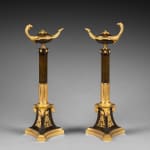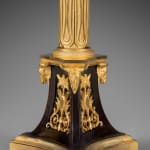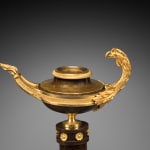Claude Galle (attributed to)
Further images
A superb and rare pair of gilt and patinated bronze candelabra, made entirely of very finely chased patinated and matte gilt bronze, each candelabrum presents a neoclassical design, with a plain column stem that emerges from a gilt bronze bouquet of wide, stylized water leaves, which rests on a knurled torus base and is surmounted by a band adorned with rosettes. The stem supports an antique lamp with a molded pedestal and a mille-raie frieze, which features on one side an eagle’s head that terminates in acanthus leaves, and on the other, a flame motif. The cover, whose handle is a bud surrounded by finely detailed leaves, may be turned over to form a drip pan to which may be fitted a candle. The high triangular base with convex sides is adorned, above, with three rams’ heads and on the reserves on its three sides with arabesque motifs depicting amphorae with flowers adorned with C-scrolls, seeds, and volutes. A molded triangular base supports the candelabra.
Paris, date circa 1805-10
Height 38.5 cm
The remarkable and unusual design of this pair of candelabra, and in particular the antique lamp surmounting it, whose cover may be turned over to form a drip pan, as well as its unusual size, more reminiscent of flambeaux than candelabra, makes it one of the most elaborate lighting instruments created during the Empire period. Their design was inspired by the antique oil lamps that were discovered during the archeological digs following the discovery of the ancient Roman cities of Herculaneum and Pompeii, near Naples. Their attribution to the bronzier Claude Galle, one of the most talented artisans of the time, is supported by stylistic similarities with other known models created by Galle, including a seven-light candelabrum that is now in the Assemblée Nationale in Paris (illustrated in Le patrimoine de l’Assemblée nationale, Editions Flohic, 1996, p. 71). Two large pairs of candelabra, smaller in size but also surmounted by antique lamps are in the Mobilier national in Paris; during the Empire they stood in Emperor Napoleon’s Salon at Saint-Cloud Palace (see M-F. Dupuy-Baylet, L’Heure, Le Feu, La Lumière, Les bronzes du Mobilier national 1800-1870, Editions Faton, Dijon, 2010, p. 212-213, catalogue n° 117).
A leader in his field, Claude Galle was born at Villepreux near Versailles and then travelled to Paris to begin an apprenticeship under the fondeur, Pierre Foy. In 1784 Galle married Foy’s daughter and on his father-in-law’s death in 1788 Galle took over the workshop, which he built up into one the finest of its kind with a workforce of about 400 craftsmen. Galle promptly moved the business to Quai de la Monnaie (renamed Quai de 1’Unité) and from 1805 operated from 60 Rue Vivienne. First listed in the trade registers in 1784 he was received as a maître-fondeur in 1786 and promptly gained the first of many commissions from the Garde-Meuble de la Couronne under Jean Hauré from 1786-88. He is known to have collaborated with Pierre-Philippe Thomire, amongst others, and was responsible for the majority of bronzes d’ameublement supplied during the Empire to Château de Fontainebleau. Other Imperial commissions included the supply of numerous vases, ewers, light fittings, figural clock cases and other fine bronze furnishings for the palaces at Saint-Cloud, the Trianons, Tuileries, Compiègne, Rambouillet and a number of the Italian palaces including Monte Cavallo, Rome and Stupinigi near Turin. Yet despite numerous important commissions Galle was often in debt, partly on account of his lavish life style and also since many of his clients, such as Prince Joseph Napoleon, failed to pay him. After his death Galle’s business was reopened and prospered under his son, Gérard-Jean Galle (1788-1846). His work can be found among the world’s finest collections including those mentioned above as well as the Musée National de Château de Malmaison, the Musée Marmottan in Paris, the Museo de Relojes at Jerez de la Frontera, the Residenz Munich and the Victoria and Albert Museum in London.







